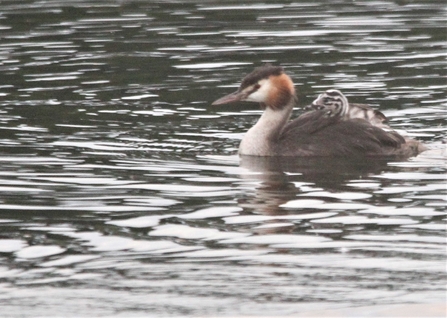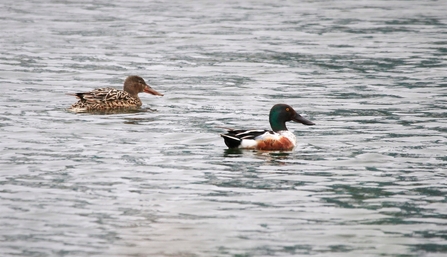
Great crested grebe
Photo credit: Chris Farthing
Shoveler pair
Photo credit: Chris Farthing

Great crested grebe
Photo credit: Chris Farthing
The rising and falling water levels of a working reservoir can be a challenge for nesting waterbirds. Great crested grebes (above) are probably the most affected species, given their habit of building nests only inches above the water. This year after a few attempts one of our pairs produced a single chick, which could be seen riding on the back of one of the parents at the end of June.
Another species which seemed keen to breed here was common tern (below). A pair were seen every day for the first half of June, with plenty of courtship behavior noted. There was fish-gifting, mating, and they even produced one egg, although it wasn’t in a suitable place and was gone by the next day. They could be an inexperienced pair, but maybe they will be back again next year.
Common terns
Photo credit: Chris Farthing
Very few pairs of shoveler (below) breed in London and we generally don’t see the species here in June, but this year a pair arrived on the 6th, staying for a few days, and we had several more sightings of up to three birds for the rest of the month. Some parts of the UK had an unusually cold May this year, and some of these birds probably had failed nests in that time.

Shoveler pair
Photo credit: Chris Farthing
On the 18th a juvenile grey heron (below) wearing a darvic ring visited. It turned out that ‘AL9’ had been ringed as a nestling at Walthamstow Wetlands on April 15th. The little egrets which were seen here through May continued for a few days at the start of June but sightings then dried up.
Grey heron
Photo credit: Chris Farthing
It has been hard to see little grebe here for some time now, they might be quietly breeding somewhere in the lagoons or they might have moved to one of the local parks where the water level stays more constant. A well-grown juvenile was seen here on the 23rd, most likely a bird which hatched elsewhere but may have flown here on one of its maiden flights.
Swifts could be seen here almost permanently through June, sometimes feeding low over the water, sometimes high and distant. The maximum count this year has been around 75, well down on the 300+ of a few years ago. The odd house martin or sand martin has sometimes been seen amongst them.
As usual in June, the reed-beds have been teeming with reed warblers, and birds can be seen commuting between the reed-bed and various bushes and trees around the site as they collect food for their young. The exact same behaviour has also been noted for reed bunting this year, with an adult male being seen going backwards and forwards from the reed-bed to one of the large oaks along the northern side.
The total number of bird species seen here in June 2023 was 57, about 3 below the historical June average.